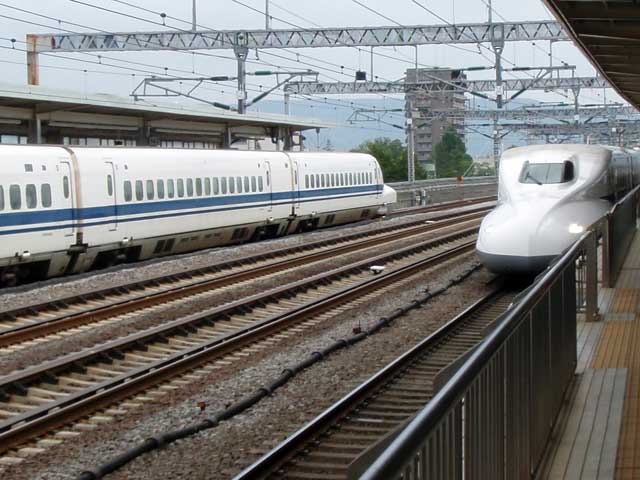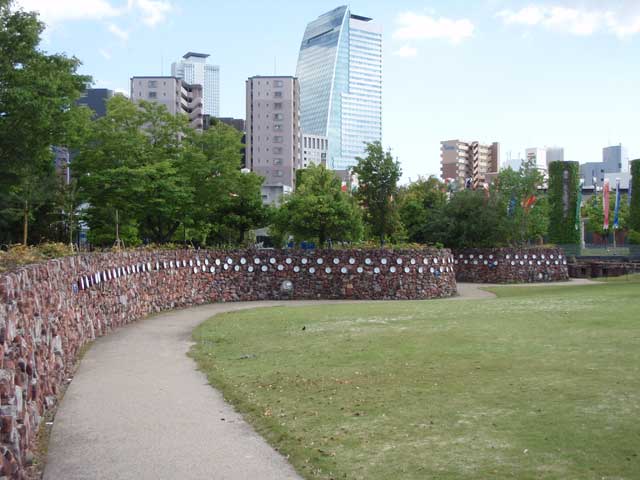
Our bullet train pulling into the station at Odawara.

The next morning we convened for breakfast, and Mason wondered if any of our breakfasts would ever repeat during our stay. Repacking the bags, we headed to the train station to catch the Japan Rail train from ōfuna to Odawara. In Odawara we boarded the Shinkansen / bullet train to Nagoya (it continues to Osaka). Occasionally the ocean was visible on the left, but most of the landscape is urban so far.
The bullet train glided into Nagoya at its appointed time, and we debarked with a goodly number of people. Once in the station, Mike consulted with the tourist office to orient ourselves to find our hotel – it was too early to check in yet – and went back to the station to catch the local sight seeing bus. We got off at Noritake Garden, the site of Noritake’s kiln and ceramics factory until they were relocated to a different site. The factory was torn down, except for certain elements – a long wall constructed from debris from the kiln demolition and the six chimneys that were cut down from 45 to 9 meters tall. The security guard told us that at one time the chimneys and the Nagoya Castle were the tallest structures in town. We stopped for lunch in the restaurant on the grounds appropriately named “Kiln”.
After lunch, Cindy, Mike, and Mason went to quickly check out the museum while Jonathan and I perused the china and porcelain available for purchase. We missed the bus to the next stop, so Cindy, Mike, and Mason snagged a taxi as they wanted to see both the castle and the Tokugawa Art Museum and time was becoming a factor. Jonathan and I walked back across the street and walked through the not-so-impressive gardens. We did spot a series of about three dozen ceramic art pieces that were quite interesting and collected a few snapshots of them.

The kiln wall - built from the rubble of the factory's kilns, with modern Nagoya rising in the background.
Catching the next bus, we arrived at Nagoya Castle. On our way in (and out) there was an impressive display of bonsai azaleas – it appeared to be a contest of some sort. Nagoya Castle burned to the ground in the air raids at the end of World War II in 1945, so the current structure is a reconstruction. Other buildings on the grounds are also being rebuilt. The most recent completion is the carriage house which positively gleamed. You could go through the building but we wanted to go through the castle first.
We passed Cindy, Mike, and Mason as they exited the castle and told them we planned on spending more time there and did not expect to get to the museum. So we wandered through the exhibits working our way up to the seventh floor observatory. I think I only took a couple of snaps there as the urban sprawl seemed equivalent from all four sides of the room. On a lower floor there was a picture of the castle (a wooden, rather than stone structure) ablaze in 1945, but I thought it would be in poor taste to take a snap of the image, especially considering who did the bombing. [There is an image on the Wikipedia link above.]
While in the observatory, they announced that it was 15 minutes to closing time, so we headed down the stairwell and out the building. On our way, we peered into the workshop where craftsmen were hand-working wooden beams that are to be used in the reconstruction of other buildings on the castle grounds. The sun angling in through the window provided some nice lighting.
The carriage house was closed as we walked by, so we didn’t get a chance to go in. We caught our bus in front of the castle and returned to the hotel to wait for Cindy, Mike, and Mason to return from the museum.
For dinner we went back to the station to check out the dining on the top floors of the Nagoya Towers. We checked the menus and found them not to our taste – especially for the prices. So we returned to the 12th and 13th floors where there was a large selection of restaurants. Choosing a “fusion” restaurant called Kihachi, we had an excellent meal, and an excellent bottle of wine.